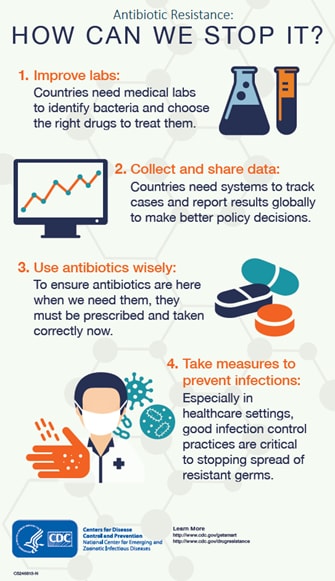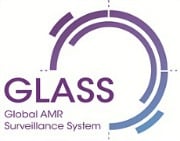
International Activities to Combat AR
Global Threat of Antibiotic Resistance
High levels of antibiotic resistance have been found in all regions of the world. New resistance mechanisms emerge and spread globally threatening our ability to treat common infectious diseases. Detecting, preventing, and controlling drug resistance requires coordinated efforts from all countries. To support the US National Strategy to Combat Antibiotic Resistant Bacteria (CARB), in addition to antibiotic drug research and development, CDC is reinforcing international collaboration and capacities for antibiotic resistance prevention, surveillance, and infection control to address the threat of drug resistance.
Global Action to Better Respond

What can we do globally to slow drug resistance and protect people? Every country—regardless of resources —can take steps to slow antibiotic resistance by preventing infections and improving antibiotic use within its borders.
- Awareness and education: Raising public awareness about this threat is an important first step.
- Surveillance: Countries need systems to track antimicrobial resistance and share findings with international partners.
- Infection, prevention and control: Infection control and hygiene are critical to stopping spread of resistant germs in healthcare settings.
- Optimize use: Ensuring that antibiotics are still effective in the future requires that they be used correctly today.
- R&D and investment: Research and development of new drugs, diagnostic tools and vaccines are a global priority.
Awareness and Education
Raising awareness about the threat of resistance and the need to improve use is critical to tackling the issue. Almost two thirds (64%) of some 10,000 people surveyed by the World Health Organization (WHO) across 12 countries say they know antibiotic resistance is an issue that could affect them and their families, but how it affects them and what they can do to address it are not well understood. For example, 64% of respondents believe antibiotics can be used to treat colds and flu, despite the fact that antibiotics have no impact on viruses.
In 2015, WHO launched the first World Antibiotic Awareness Week, aimed at raising awareness of antimicrobial resistance and promoting change through public communication.
Learn more:
- Get Smart In Doctor’s Offices (Outpatient)
- Get Smart In Healthcare (Inpatient)

“There are significant gaps in the information available on the development and global economic implications of antimicrobial resistance. Stronger networks of information sharing and a global strategic research agenda would improve global understanding of antimicrobial resistance.” – World Health Organization
Collaborating with Ministries of Health, CDC country offices, and implementing partners, CDC is providing technical assistance to partners in building AMR laboratory capacity, surveillance systems, and infection control capacity for countries to detect, track, and respond to antimicrobial resistance. Data from these surveillance systems will be used to target intervention strategies from the national to local level as well as develop and promote antibiotic stewardship programs.
Global Antimicrobial Resistance Surveillance System (GLASS)
GLASS provides a standardized approach to the collection, analysis and sharing of data on antimicrobial resistance at a global level.
Infection Prevention and Control
CDC programs, in support of U.S. CARB[63 pages] and the Global Health Security Agenda, work with countries to help build capacity for infection control. Capacities for infection control prevent the spread of drug resistant infections, along with many other infectious disease threats —such as Ebola, malaria, and Middle East Respiratory Syndrome (MERS).
However, more work is needed worldwide. Sustainable infection control requires ongoing investments in healthcare infrastructure, staffing, and knowledge.
However, more work is needed worldwide. Sustainable infection control requires ongoing investments in healthcare infrastructure, staffing, and knowledge.
Optimize Use
Key driving factors behind drug resistance are the overuse and misuse of antibiotics.
Access to antibiotic drugs varies widely around the world. Some countries rely on physician or pharmacist orders for antibiotics, in others, antibiotics are freely available over the counter or access is lacking. Early efforts to improve antibiotic access and use have focused on the education of both doctors and patients. Strategies to measure antibiotic use, use vaccines to prevent infections that can promote antibiotic use, and better diagnostics to rapidly determine whether antibiotics are warranted all contribute to improved antibiotic use.
Global Action on AMR
At the Sixty-eighth World Health Assembly in May 2015, the World Health Assembly endorsed a global action plan to tackle antimicrobial resistance, including antibiotic resistance, the most urgent drug resistance trend.
The global action plan sets out five strategic objectives:
- to improve awareness and understanding of antimicrobial resistance;
- to strengthen knowledge through surveillance and research;
- to reduce the incidence of infection;
- to optimize the use of antimicrobial agents; and
- develop the economic case for sustainable investment that takes account of the needs of all countries, and increase investment in new medicines, diagnostic tools, vaccines and other interventions.
What CDC is Doing
CDC continues to combat antimicrobial resistance globally:
- CDC programs are engaged on the ground with partner governments around the world
- CDC is joining with other U.S. government agencies and global partners to advance the Global Health Security Agenda (GHSA). CDC has multiple roles in shaping and executing GHSA through:
- Coordination: CDC works closely with other parts of the U.S. government and partner nations to prevent epidemics, detect threats early, and respond rapidly and effectively.
- Technical support: CDC uses existing investments and relationships in global health to deliver technical expertise and help partner nations meet global health security goals.
- Read more about the GHS AMR Action Package here.
- The Transatlantic Taskforce on Antimicrobial Resistance (TATFAR) aims to improve cooperation between the U.S. and the EU on urgent antimicrobial resistance issues. Learn more about CDC and TATFAR here.
- CDC’s Antibiotic Resistance Solutions Initiative is part of a broader national strategy to combat antibiotic resistance and aims to facilitate action in every state, accelerate outbreak detection and prevention innovation, improve antibiotic use, and reduce antibiotic resistance. The initiative provides a comprehensive approach based on the National Action Plan for Combating Antibiotic-Resistant Bacteria[63 pages](CARB).
National Action Plan to Combat Antibiotic-Resistant Bacteria (CARB)
The National Action Plan to Combat Antibiotic-Resistant Bacteria emphasizes the importance of the U.S. government coordinating on AR internationally. Goal 5 of the National Action Plan focuses on improving international collaboration and capacities for antibiotic-resistance prevention, surveillance, control, and antibiotic research development. CDC is leading or involved in the following aspects of Goal 5.
United Nations General Assembly
CDC, along with other federal agencies, participated in a UN General Assembly High-Level Meeting on Antimicrobial Resistance to help combat antibiotic resistance worldwide. This was only the fourth time a health issue was discussed by the UN General Assembly, demonstrating the urgency of this threat. The meeting’s objective was to increase awareness of antibiotic resistance and get strong commitment from the national, regional, and international community.






















.png)









No hay comentarios:
Publicar un comentario